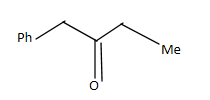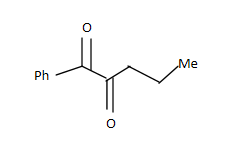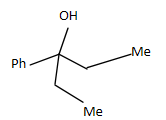
Benzonitrile on reaction with
A.

B.

C.

D.





Answer
501k+ views
Hint:
Complete step by step answer:
The reaction of Grignard reagents with nitriles is,
So the reaction between benzonitrile and
So the answer is A.
Additional Information:- The Grignard reaction is an organometallic chemical reaction in which alkyl, allyl, vinyl or aryl–magnesium halides add to a carbonyl group in an aldehyde or ketone. This reaction is important for the formation of carbon-carbon bonds. Grignard compounds are popular reagents in organic synthesis for creating new carbon-carbon bonds. Pure Grignard reagents are extremely reactive solids. They are normally handled as solutions in solvents such as diethyl ether or tetrahydrofuran, which are relatively stable as long as water is excluded. Grignard reagents are prepared by treating an organic halide with magnesium metal. Cyclic or acyclic ethers are required to stabilize the organomagnesium compound. The reaction to form Grignard reagents involves the use of magnesium ribbon. All magnesium is coated with a passivating layer of magnesium oxide, which inhibits reactions with the organic halide. Grignard reagents are more sensitive to moisture and oxygen. Grignard reagents are nucleophiles in nucleophilic aliphatic substitutions. Grignard reagents serve as a base for protic substances.
Note:
Grignard reagents are basic and react with alcohols, phenols to give alkoxides. In the reaction between aromatic nitriles and Grignard reagent at first the imine salt is formed and then the produced imine salt reacts with water to give ketone.
Complete step by step answer:
The reaction of Grignard reagents with nitriles is,
So the reaction between benzonitrile and
So the answer is A.
Additional Information:- The Grignard reaction is an organometallic chemical reaction in which alkyl, allyl, vinyl or aryl–magnesium halides add to a carbonyl group in an aldehyde or ketone. This reaction is important for the formation of carbon-carbon bonds. Grignard compounds are popular reagents in organic synthesis for creating new carbon-carbon bonds. Pure Grignard reagents are extremely reactive solids. They are normally handled as solutions in solvents such as diethyl ether or tetrahydrofuran, which are relatively stable as long as water is excluded. Grignard reagents are prepared by treating an organic halide with magnesium metal. Cyclic or acyclic ethers are required to stabilize the organomagnesium compound. The reaction to form Grignard reagents involves the use of magnesium ribbon. All magnesium is coated with a passivating layer of magnesium oxide, which inhibits reactions with the organic halide. Grignard reagents are more sensitive to moisture and oxygen. Grignard reagents are nucleophiles in nucleophilic aliphatic substitutions. Grignard reagents serve as a base for protic substances.
Note:
Grignard reagents are basic and react with alcohols, phenols to give alkoxides. In the reaction between aromatic nitriles and Grignard reagent at first the imine salt is formed and then the produced imine salt reacts with water to give ketone.
Recently Updated Pages
Master Class 12 Business Studies: Engaging Questions & Answers for Success

Master Class 12 English: Engaging Questions & Answers for Success

Master Class 12 Social Science: Engaging Questions & Answers for Success

Master Class 12 Chemistry: Engaging Questions & Answers for Success

Class 12 Question and Answer - Your Ultimate Solutions Guide

Master Class 11 Economics: Engaging Questions & Answers for Success

Trending doubts
Draw a labelled sketch of the human eye class 12 physics CBSE

a Tabulate the differences in the characteristics of class 12 chemistry CBSE

Which one of the following is a true fish A Jellyfish class 12 biology CBSE

Why is the cell called the structural and functional class 12 biology CBSE

Differentiate between homogeneous and heterogeneous class 12 chemistry CBSE

Write the difference between solid liquid and gas class 12 chemistry CBSE




